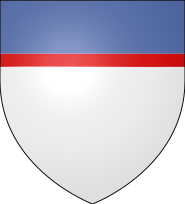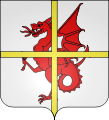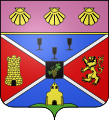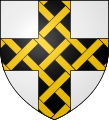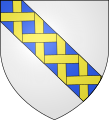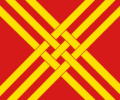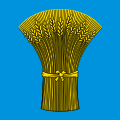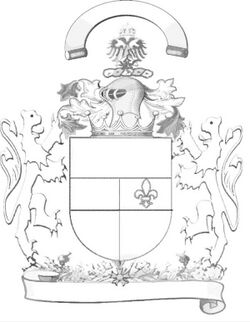Fillet (heraldry)
In English-language heraldry, the fillet is considered a diminutive of the chief. It is defined as occupying one fourth the width of the chief and typically positioned at its bottom edge.[1] When so positioned the chief is blazoned as supported by the fillet; but, when the chief is charged by the fillet, when the fillet positioned at its top edge[2] or middle, the chief is blazoned as surmounted.[3] In French heraldry, terms for this charge are divise[4] and filet en chef.[5] The term chef retrait has also been used.[6] The fillet or divise placed beneath the chief is of a different tincture than the field,[7] evidently to avoid violations of the rule of tincture (see Berry 1828[8]).
This use of the term, as the diminutive of an ordinary, is to be distinguished from other uses of the term fillet in heraldry. See section #Other uses of fillet in a heraldic context below.
Fillet as adjective
The adjective 'fillet'—as in fillet cross, fillet saltire—is used to denote a mode of diminution achieved by a reduction in thickness, to typically one-fourth that of the ordinary,[9] without any corresponding reduction in the extent of the charge, in terms of length or width, or both. The fillet cross and fillet saltire occupy the full length and breadth field, as the cross and saltire as ordinaries do. The fillet bordure adheres to the outer edges of the field in the same manner as the bordure. In French heraldry, the 'fillet bordure' is the filière.[10]
Filleting and fimbriation
The terms fillet and fimbriation share etymological roots with words associated with clothing, sewing and stitching. The word fillet derives from the Middle English and Old French filet, a diminutive of thread.[11] But the heraldic use may derive more proximately from use of the term for an item of clothing, a headband of white silk or linen worn to indicate sovereignty.[12] In its practical inspiration dating to the Age of Chivalry, as a cloth worn around the helmets of knights, sometimes by sons of nobles as a mark of cadency, the fillet is related to another heraldic charge, the lambel or label.[13] But the meaning of the word fillet extends to bands of metal historically worn around the head as marks of distinction, as crowns.[14] For its part, fimbriate derives from the Latin for 'fibers, fringe, and thread' and more proximately from the word for the skirt or hem of a garment, "implying an ordinary or charge bordered all round".[15] The use of the term 'fimbriation' for the bordering of ordinaries like crosses and bends that extends only to the edge of the field and does not fully encompass the charge, though common, is considered by authorities like William Berry to be likely mistaken.[16]
Other uses of fillet in a heraldic context
Aside from the use of the term fillet for the diminutive of an ordinary as a narrow band, the term is also used in a figurative-representational manner drawing on the meanings of fillet discussed above, as ribbon, cloth headband, or band of metal. In the first case, it is used to describe a decorative element of an achievement of arms, the figurative representation of a ribbon entwined around a helmet. The fillet in this sense is also frequently incorporated (twisted into) the torse.[17] In the second, the term is used for representations of cloth wrapped around the heads of 'Moors' or 'Saracens'.[18] When used thusly, the human figures portrayed with a candida fascia, after the diadem of the Roman kings, are blazoned diadameté.[19] A third use, resembling the two preceding, is for the representation of a band of cloth or bandage used to bundle a sheaf of wheat or arrows together.[20] Finally, the term is used for representations of a metal band, of gold, as a plain crown or as a component of a more elaborate crown.[21] A derivative of this usage, is the use of fillet to describe a design component of some heraldic representations of the fleur-de-lis,[22] such as that seen on the Flag of Quebec or the Flag of the Republic of Bosnia and Herzegovina (see section #Band as design element of fleur-de-lis below).
Gallery
Coats of arms
See also the Coat of arms of the Harvard Medical School, blazoned as "sustained by a fillet compony".
Fillet in base
Baons-le-Comte, France
Fillet cross and fillet saltire
As component of crosses parted and fretted
As component of fretty variation of the field
On flags
Fillet-adjacent diminutives*
Flag of the Territory of American Samoa, US (perhaps fillet chevron)
Flag of Saint Lucia (perhaps fillet chevron)
*In English language vexillology, many of these would likely be blazoned as instances of fimbriation or cottissing.[23] For 'fillet esquarre' as border of canton on two sides, see Esquarre (heraldry).
Fillet cross and saltire
Flag of Southern Leyte, Philippines (Fillet offset cross enhanced)
As component of cross parted and fretted
As component of cross otherwise interlaced
As component of Jumelle and similar
As component of Tierce and other charges parted
Flag of Podgorica, Montenegro
As cost or single cottice
Source:[24]
Fillet bordure or filière
Flag of Kyiv, Ukraine
Fillet orle or tressure
See also Flag of Athens, Greece
Other uses of term fillet
As headband or diadem
As ribbon tying sheaf
Flag of Morayshire, Scotland, United Kingdom
Band as design element of fleur-de-lis
See also
Chief (heraldry)
Fimbriation
Esquarre (heraldry)
Ordinary (heraldry)
Charge (heraldry)
Liste de pièces héraldiques
References
- ↑ Manual of Heraldry. London: Jeremiah How. 1846. p. 18. https://www.google.com/books/edition/The_manual_of_heraldry/fSsEAAAAQAAJ?hl=en&gbpv=1.
- ↑ Elvin, Charles Norton (1889). A dictionary of heraldry : with upwards of two thousand five hundred illustrations. London: Kent and Co.. p. xviii. https://archive.org/details/dictionaryofhera00elvi/page/n47/mode/2up?q=Surmounte.
- ↑ Berry, William (1828). Encyclopaedia heraldica; or, Complete dictionary of heraldry. London: Sherwood, Gilbert and Piper. p. CHI-CHU. https://archive.org/details/encyclopaediaher01berr/page/n217/mode/2up?q=chief.
- ↑ de Mailhol, Dayre (1895). Dictionnaire historique et héraldique de la noblesse française. Paris: Direction & Redaction [Impr. Ch. Lépice]. p. 90. https://www.google.com/books/edition/Dictionnaire_historique_et_h%C3%A9raldique_d/06SWZuK_A0IC?hl=en&gbpv=1&dq=divise+%2B+heraldique&pg=PP58&printsec=frontcover.
- ↑ Woodward, John (1896). A Treatise on Heraldry, British and Foreign With English and French Glossaries · Volume 1. Edinburgh and London: W. & A.K. Johnston. p. 473. https://www.google.com/books/edition/A_Treatise_on_Heraldry_British_and_Forei/QwMNAAAAYAAJ?hl=en&gbpv=1&dq=filet+%2B+heraldry&pg=PA473&printsec=frontcover.
- ↑ Gough, Henry; Parker, James (1894). A Glossary of Terms Used in Heraldry (New ed.). Oxford and London: J. Parker and Co.. p. 112. https://books.google.com/books?id=luMMAAAAYAAJ.
- ↑ Owen, W. (1754). A New and Complete Dictionary of Arts and Sciences, Vol. 2. London. p. 1228. https://www.google.com/books/edition/A_New_and_Complete_Dictionary_of_Arts_an/UNuy6hDfomYC?hl=en&gbpv=0.
- ↑ Berry, William (1828). Encyclopaedia heraldica; or, Complete dictionary of heraldry. London: Sherwood, Gilbert and Piper. p. FIG-FIR. https://archive.org/details/encyclopaediaher01berr/page/n217/mode/2up?q=fillet.
- ↑ Berry, William (1828). Encyclopaedia heraldica; or, Complete dictionary of heraldry. London: Sherwood, Gilbert and Piper. p. CRO-CRO. https://archive.org/details/encyclopaediaher01berr/page/n217/mode/2up?q=fillet.
- ↑ Berry, William (1828). Encyclopaedia heraldica; or, Complete dictionary of heraldry. London: Sherwood, Gilbert and Piper. p. FIG-FIR. https://archive.org/details/encyclopaediaher01berr/page/n217/mode/2up?q=fillet.
- ↑ "Fillet". Merriam-Webster. https://www.merriam-webster.com/dictionary/fillet.
- ↑ Guillim, John (1679). A display of heraldry : manifesting a more easie access to the knowledge thereof than hath been hitherto published by any, through the benefit of method. London: R. Blome. p. 21. https://archive.org/details/gri_33125009310737/mode/2up?q=fillet.
- ↑ Nisbet, Alexander (1804). A System of Heraldry, Speculative and Practical: with the True Art of Blazon ... Illustrated with Suitable Examples of Armorial Figures, and Achievements of the Most Considerable Surnames and Families in Scotland (Second ed.). Edinburgh: Alex Lawrie & Co.. p. 6. https://www.google.com/books/edition/A_system_of_heraldry_speculative_and_pra/MW1cO7s9MuQC?hl=en&gbpv=1&dq=fillet+tincture+heraldry&pg=PA6&printsec=frontcover.
- ↑ Nisbet, Alexander (1804). A System of Heraldry, Speculative and Practical: with the True Art of Blazon ... Illustrated with Suitable Examples of Armorial Figures, and Achievements of the Most Considerable Surnames and Families in Scotland (Second ed.). Edinburgh: Alex Lawrie & Co.. p. 39. https://www.google.com/books/edition/A_system_of_heraldry_speculative_and_pra/MW1cO7s9MuQC?hl=en&gbpv=1&dq=fillet+tincture+heraldry&pg=PA6&printsec=frontcover.
- ↑ Berry, William (1828). Encyclopaedia heraldica; or, Complete dictionary of heraldry. London: Sherwood, Gilbert and Piper. p. FIG-FIR. https://archive.org/details/encyclopaediaher01berr/page/n217/mode/2up?q=fillet.
- ↑ Berry, William (1828). Encyclopaedia heraldica; or, Complete dictionary of heraldry. London: Sherwood, Gilbert and Piper. p. FIG-FIR. https://archive.org/details/encyclopaediaher01berr/page/n217/mode/2up?q=fillet.
- ↑ Fox-Davies, Arthur Charles (1909). A Complete Guide to Heraldry. London and Edinburgh: T. C. & E. C. Jack. pp. 402–403. https://en.wikisource.org/wiki/A_Complete_Guide_to_Heraldry/Chapter_25.
- ↑ Nisbet, Alexander (1804). A System of Heraldry, Speculative and Practical: with the True Art of Blazon ... Illustrated with Suitable Examples of Armorial Figures, and Achievements of the Most Considerable Surnames and Families in Scotland (Second ed.). Edinburgh: Alex Lawrie & Co.. p. 6. https://www.google.com/books/edition/A_system_of_heraldry_speculative_and_pra/MW1cO7s9MuQC?hl=en&gbpv=1&dq=fillet+tincture+heraldry&pg=PA6&printsec=frontcover.
- ↑ Nisbet, Alexander (1804). A System of Heraldry, Speculative and Practical: with the True Art of Blazon ... Illustrated with Suitable Examples of Armorial Figures, and Achievements of the Most Considerable Surnames and Families in Scotland (Second ed.). Edinburgh: Alex Lawrie & Co.. p. 37. https://www.google.com/books/edition/A_system_of_heraldry_speculative_and_pra/MW1cO7s9MuQC?hl=en&gbpv=1&dq=fillet+tincture+heraldry&pg=PA6&printsec=frontcover.
- ↑ Berry, William (1828). Encyclopaedia heraldica; or, Complete dictionary of heraldry. London: Sherwood, Gilbert and Piper. p. BAN-BAR. https://archive.org/details/encyclopaediaher01berr/page/n217/mode/2up?q=fillet.
- ↑ Nisbet, Alexander (1804). A System of Heraldry, Speculative and Practical: with the True Art of Blazon ... Illustrated with Suitable Examples of Armorial Figures, and Achievements of the Most Considerable Surnames and Families in Scotland (Second ed.). Edinburgh: Alex Lawrie & Co.. p. 39. https://www.google.com/books/edition/A_system_of_heraldry_speculative_and_pra/MW1cO7s9MuQC?hl=en&gbpv=1&dq=fillet+tincture+heraldry&pg=PA6&printsec=frontcover.
- ↑ Rothery, Guy Cadogan (1915). A. B. C. of Heraldry. London: Stanley Paul and Co.. pp. 167–174. https://www.google.com/books/edition/A_B_C_of_Heraldry/ry_QAAAAMAAJ?hl=en&gbpv=1.
- ↑ "Dictionary of Vexillology – FIMBRIATION (or FIMBRIATED)". https://www.crwflags.com/fotw/flags/vxt-dvf1.html#fimbriation.
- ↑ "Dictionary of Vexillology – COTTICE". https://www.crwflags.com/fotw/flags/vxt-dvco.html#cottice.
This article needs additional or more specific categories. (December 2023) |
 |
